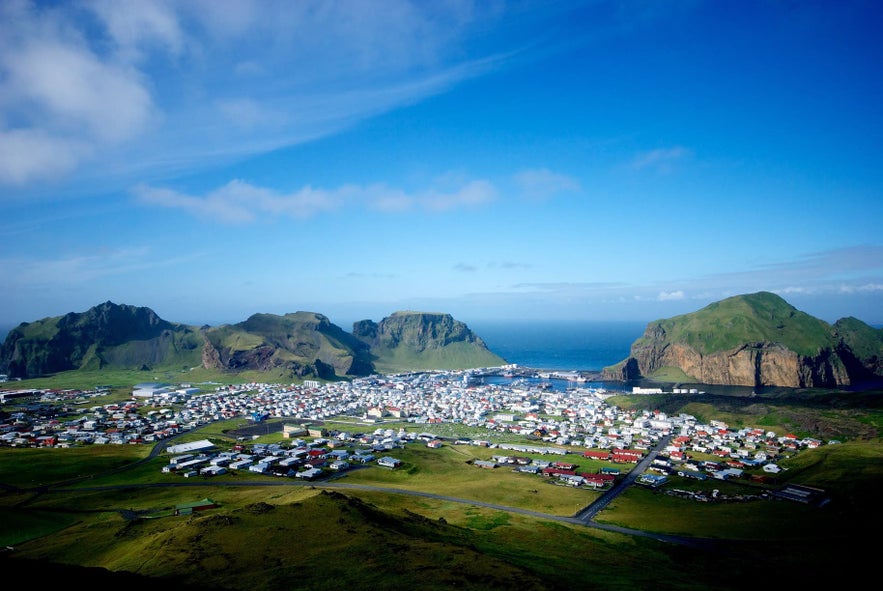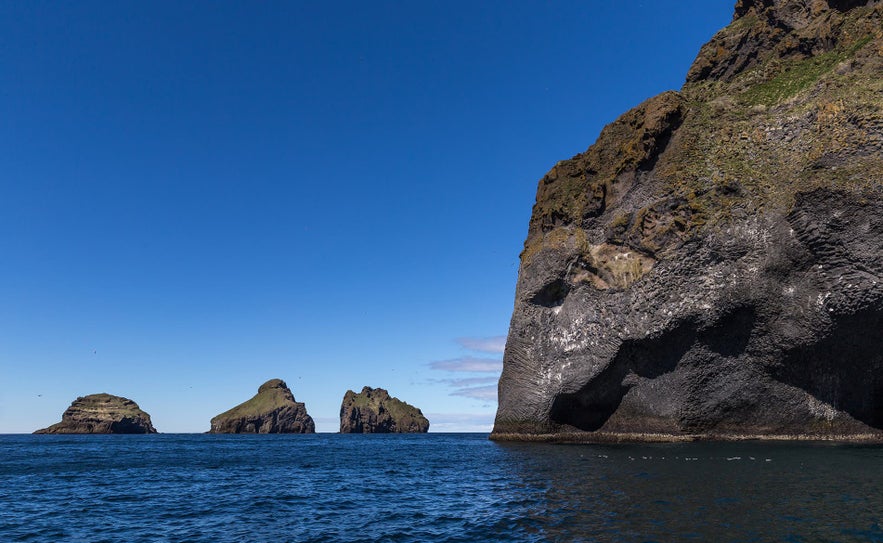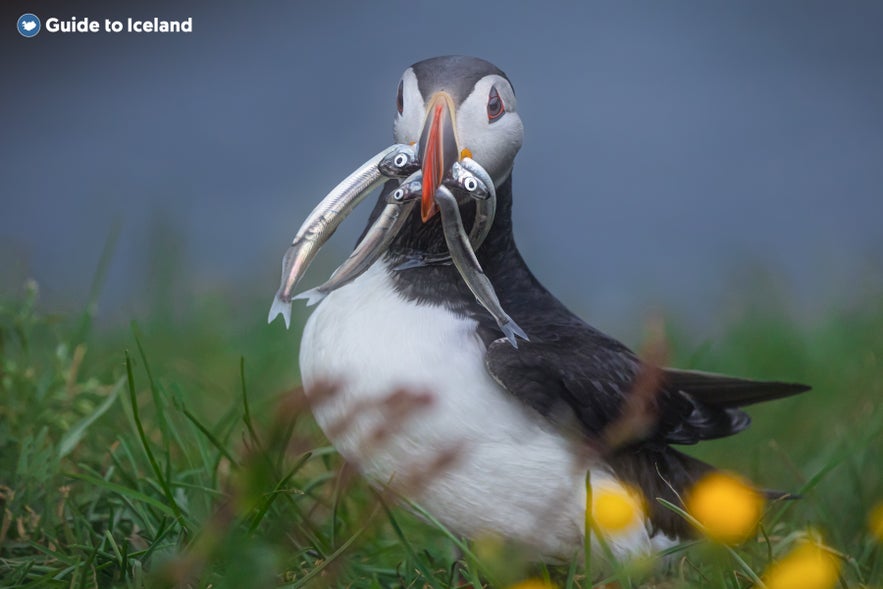
Vestmannaeyjar (Westman Islands) Travel Guide

The Westman Islands, or Vestmannaeyjar, are an archipelago of 15 islands and 30 rock stacks off the South Coast of Iceland. Aside from their incredible natural beauty, the islands have the world’s largest population of nesting puffins in summer and their own fascinating history.
Explore these islands on a Westman Islands tour or package vacation.
History of the Westman Islands
The history of the Westman Islands is as dark as it is intriguing, beginning at the very start of Iceland’s history, with the first family to settle here.
The first person renowned for permanently settling Iceland was a man called Ingólfr Arnarson (although it should be noted that he hardly came alone; he was accompanied by his wife Hallveig Fróðadóttr and several slaves). His half-brother joined him in the country, a few years later, but met his death at the hands of two of his own captured men.
These slaves attempted to flee and hide, to escape Arnarson’s vengeance. They reached the Westman Islands, but unfortunately, were found by ‘Iceland’s father’ and killed in retribution.
The islands since have been named after these men; they were Irish slaves, and at the time, the Irish were called ‘Westmen’, as Ireland was thought to be the westernmost landmass before Iceland’s discovery.
This brutal beginning would be a hint at the later events to occur on and shape the archipelago.
The largest island, Heimaey, was settled in the early era, and the people on it lived off the fertile oceans, puffins, and eggs. Life was challenging but manageable until a terrible tragedy occurred in 1627.
At the height of the Ottoman Empire, it was Barbary Pirates from Algiers who ruled the seas, and they managed to find their way to this little island. They took control of it for three days, before setting off back home with 237 slaves.
The vast majority of these lived out the rest of their lives in bondage, though some were ransomed back in 1638.
The trials of the voyage and their captivity were captured in a novel by a priest who managed to escape in 1628.
Unfortunately, this was not the last major calamity to befall the islands.

In the 20th Century, it seemed that the Westman Islands had overcome their hardships, modernized, and were better connected to the mainland. That, however, was to be overturned in 1973.
At 01.55, on January 20th, a fissure tore open in the middle of the town of Heimaey, and the previously unknown Eldfell volcano began to erupt violently. In hours, it had torn across the island, spurting fountains of lava height in the air and pouring noxious gasses into the atmosphere.
Unbelievably, however, no one was killed. There was an emergency plan for a situation such as this, and thankfully, storms the days before meant that the whole fishing fleet was docked in the harbor. The entire population of the island was taken to safety.
That is not to say, however, that the work was done. 5,300 people’s homes were in the town, and the Icelandic authorities were desperate to do what they could to help protect them. At the time, the US had a NATO base in the country, and their help was enlisted.
By pumping seawater onto the great lava fronts, it was possible to cool the molten rock, slow it, and change its direction.
This innovative, previously unused technique was particularly effective when it came to protecting the harbor. It seemed at one point that the eruption may have closed it entirely, effectively destroying the island’s economy. However, by spraying the lava, the harbor was actually enclosed more and improved.
When the eruption ended, the island slowly repopulated to about 85 percent of its previous population; about one-fifth of the buildings were destroyed.
The town, however, now had a long stretch of new land on which to build a runway and a volcano in its center to draw guests. Ever since, the Westman Islands have recovered as a popular tourist destination.

The Westman Islands today
Today, the Westman Islands have attracted thousands of visitors for years for a variety of reasons. Many wish to visit the Eldborg crater and learn about the eruption in depth at the Eldheimar Museum. Others come for incredible nature opportunities.
First and foremost, there are chances for puffin watching. Ten million puffins nest in Iceland between May and September, and more of them come to the Westman Islands than anywhere else.
They nest in cliffs, crags, and sea stacks and can be easily seen by traveling on foot or by boat. Towards the end of the season, many of the pufflings get confused by the lights of the town as they try to make their way to the ocean and end up in the streets; it is thus a local tradition amongst the children to collect them and throw them in the sea.
Some business-savvy young ones used to even collect them up and ‘sell’ them to tourists to release.
The puffins are just one of the thirty or so species that nest on the islands, but they are by far the most abundant.

The Westman Islands also boast some of the best whale-watching opportunities in the country, with Fin, Minke, and Humpback Whales seen often in summer and Orcas throughout the year.
Heimaey itself is home to the world's first beluga whale sanctuary. In exchange for a donation fee to the charity, visitors can meet Little White and Little Grey in their homes in Klettsvik Bay.
Things to do in the Westman Islands
Following is a list of ideas for things to do in the Westman Islands.
-
Visit Heimaey Island: This is the largest island in the group and is home to most of the local population. It offers plenty of outdoor activities, including hiking, bird watching, and boat tours.
-
Visit Eldfell volcano: This volcano erupted in 1973, causing the evacuation of the island's population. Today, you can hike to the summit of Eldfell to see the crater and enjoy the spectacular views of the surrounding landscape.
-
Explore Stórhöfði: This is the southernmost point of the island and is a popular spot for birdwatching. You can see puffins, guillemots, and other seabirds nesting on the cliffs.
-
Visit the Eldheimar Museum: This museum tells the story of the 1973 volcanic eruption and its impact on the local community. It features exhibits on the history of the island and the eruption, as well as a theatre showing a film about the eruption.
-
Take a boat tour: There are several companies offering boat tours around the islands, which is a great way to see the rugged coastline and the variety of wildlife in the area, including whales, dolphins, and seabirds.
-
Visit the Sæheimar Aquarium: This aquarium is home to a variety of marine animals, including puffins, seals, and various fish species. It also has exhibits on the history of fishing in the area and the local marine environment.
-
Visit the Herjólfsdalur Valley: This valley is located on the west side of the island and is home to several hiking trails. It is also the site of an old farmstead and a historic church.
-
Enjoy the local cuisine: The Westman Islands are known for their fresh seafood, especially langoustine and cod. There are several restaurants on the island offering local dishes as well as traditional Icelandic cuisine.
Getting to the Westman Islands
The ferry Herjolfur sails to the Westman Islands from the town of Landeyjahöfn, on the south shore of Iceland, for the shortest journey. In poor conditions, particularly between November and March, it may instead leave from Þorlákshöfn. It is also possible to fly to the islands from Reykjavík Domestic Airport.
Attractions Nearby
Popular categories

Download Iceland’s biggest travel marketplace to your phone to manage your entire trip in one place
Scan this QR code with your phone camera and press the link that appears to add Iceland’s biggest travel marketplace into your pocket. Enter your phone number or email address to receive an SMS or email with the download link.

















